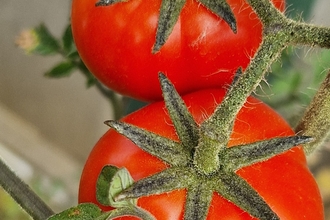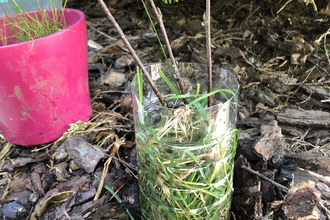Wildlife Gardening for Beginners: Growing Nectar, Pollen, Berries and Seeds
Foxgloves by Richard Burkmarr
Whilst doing my wildlife gardening research, I came across so many different suggestions on what plants to grow for wildlife. There is a lot of advice out there for particular groups of species like bees, butterflies, bats and hedgehogs. I am all for making things easy, so the simplest idea I came across was just to mow less, my partner does this in his garden to great success.
Mow less
You can either leave a patch or border totally unmown, mow less often, or not mow as low. All of these techniques will provide hiding places for animals, and allow flowers to grow in your lawn, which are good for insects. My partner lets his neighbours know that it is all about the wildlife and not that he is too lazy to cut the lawn, by mowing a path through it. He also mows his once a year in late summer after the flowers have seeded. It really is that easy!

An area less mowed by Andrew Chapman
Choose wildlife-friendly
If you have a gap and want to fill it with something that looks nice and is good for wildlife, there are many plants to choose from. It is good to have a mix of species that flower at different times of the year to provide for pollinators (like bees and butterflies) throughout the growing season. Our Reserves Officer David has written a blog about the plants for wildlife in his garden. I visited many different websites on my research and have tried to list species here that were recommended in several different places.
|
|
Early-season flowerers |
Mid-season flowerers |
Late-season flowerers |
|
Native |
|
|
|
|
Non-native |
|
|
Ice plant (Hylotelephium spectabile)
|
Create a wildflower meadow
In my own yard, I have gone for the easy option of sowing a packet of bee-friendly seeds in a pot that will hopefully give a mix of good species, but if you have a larger area that has low fertility, you could consider seeding a wildflower meadow. See how my colleague Fiona did this in her recent blog.
Before sowing, you can either remove the top layer of soil or scuff the surface a bit to leave some bare patches. Reputable seed merchants will help you choose a mix that works for your soil type.
One of the new things I learned when researching this topic is that many flowers suggested for wildlife are perennial, and are therefore slow-growing and may not flower in the first year. You can sow your wildflower mix alongside a few annual flowers that will provide nectar and cover in the first year whilst the perennials are getting going. Here are some suggestions:
Annuals:
Perennials
Trees and shrubs
If you are lucky enough to have more space in your garden, or perhaps have a blank canvas and want to add some trees and shrubs, here are some native species that are great for either pollen, nectar, fruit or seeds. Make sure you know how big they might grow before planting. I have grown my own oak tree from an acorn and loved it, but please learn from my experience, and make sure that you:
- establish where you are going to plant something before starting to grow it
- don’t wait until it is taller than you before transporting it to its new home!

Community Garden Updates: Summer Round Up!
Supporter Engagement & Communities Officer, Viktoria, gives an update on all the wonderful work that has been done at our Rushden…

Homemade Hoverfly Lagoons
With the latest Wild About Gardens focus on hoverflies, Danielle Page talks us through how to create one particular habitat to tempt…
Community Garden Updates: December 2024
Find out all about what we've been up to at the Community Garden at Rushden Lakes this Autumn, including October Half Term and…






























